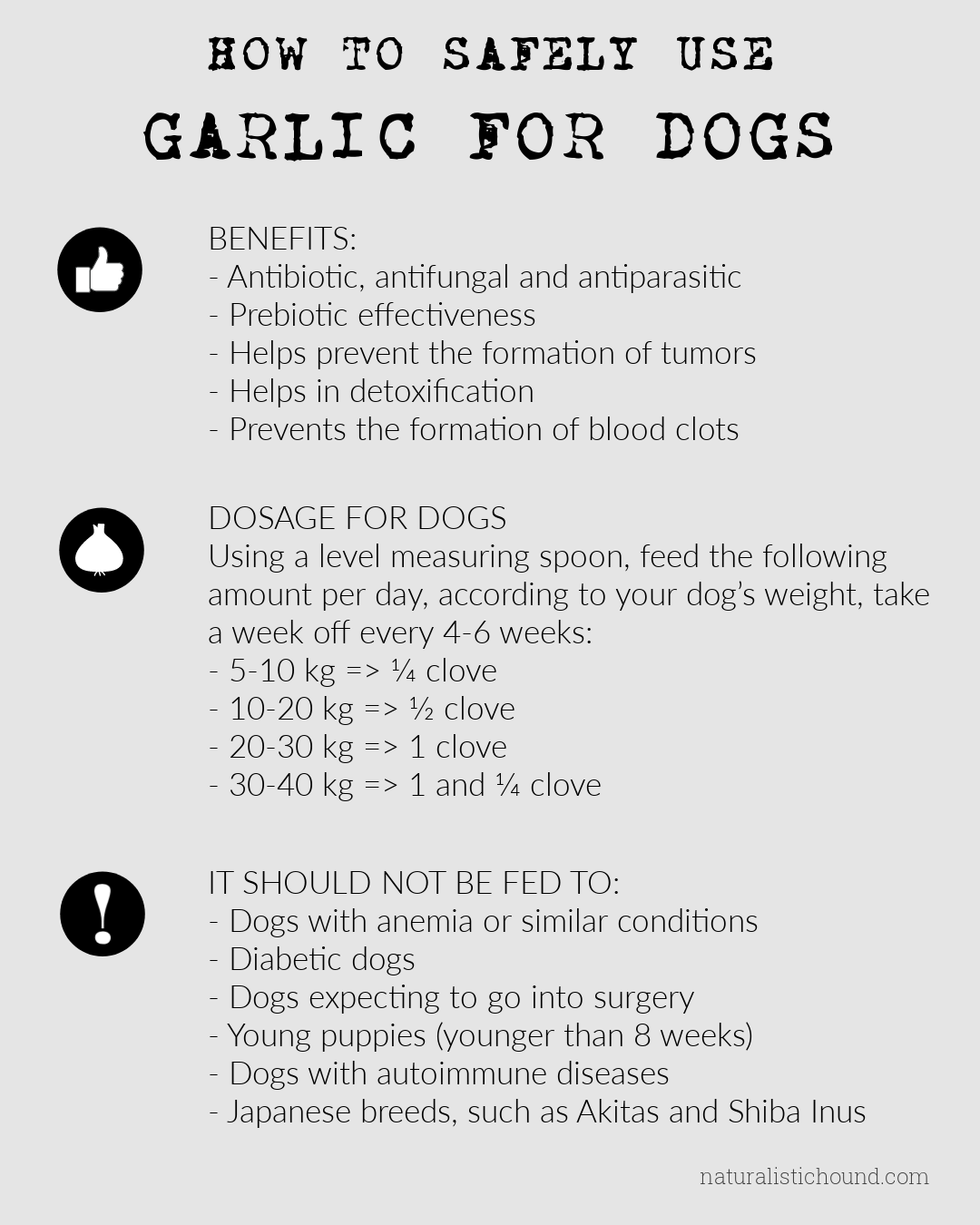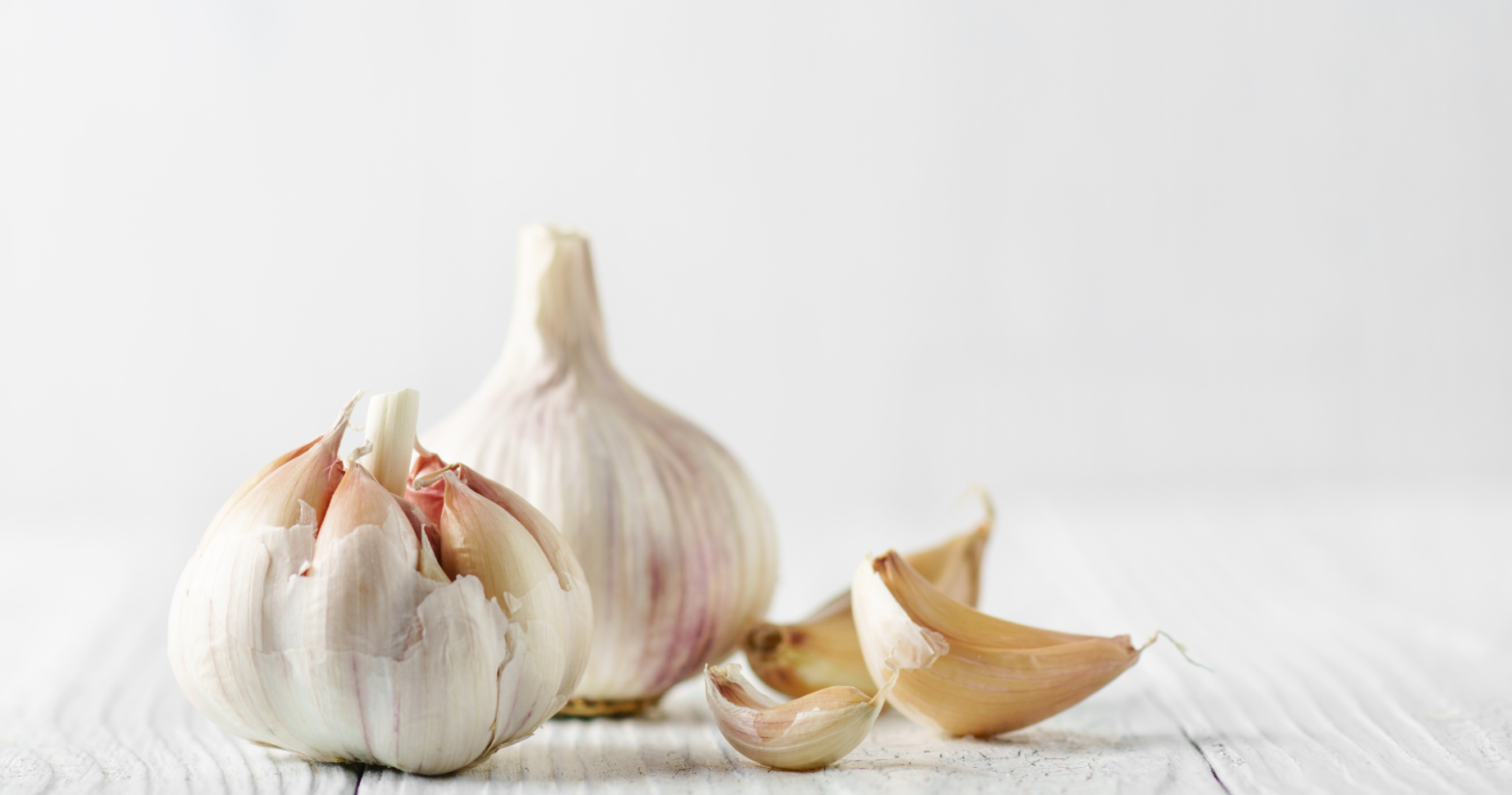In a previous post I mentioned Garlic among a list of optional ingredients to add for a delicious and healthy Bone Broth recipe for dogs.
In this post I’d like to debunk the myth that Garlic should be avoided at all costs – in fact, you have nothing to fear and everything to gain in feeding Garlic to your dog (in the correct way and amounts).
Why the Misunderstanding?
The misconceptions about the use of Garlic comes from that fact that Garlic belongs to the Allium family, together with onions, chives, and leeks, which are poisonous to dogs and cats.
Garlic contains thiosulphate, a chemical responsible for causing damages to the red blood cells (making them more likely to rupture) leading to anemia. Red blood cells oxygenate tissues, a decrease in these cells, can lead to sickness and even death.

Why Garlic Is So Good!
Some of the most important benefits Garlic can have on your dog are:
- Antibiotic, antifungal and antiparasitic – Garlic is a potential antibiotic and shows an effective performance against the bacteria resistant to pharmaceutical antibiotics. Allicin — the major biologically active component of garlic — exhibits antibacterial and antifungal properties and is used in medical treatment and studies.
- Helps prevent the formation of tumours – Dogs fed Garlic have shown improvements in case of cancers of the colon, lung, stomach, and rectum. The compounds in Garlic increase immunity and enhance natural killer T cells (killer T cells destroy pathogenic bacteria and cancer cells.)
- Helps in detoxification – Garlic helps detoxify the body. It supports beneficial bacteria in the digestive tract and eliminates harmful bacteria. There are at least six components inside a garlic bulb that can help enhance liver function and help in the flushing of toxins from the body. Garlic breaks down wastes before they enter the bloodstream. It also helps your dog assimilate nutrients and eliminate wastes through the entire digestive tract.
- Prevents the formation of blood clots – Garlic is known for its beneficial impact on circulation and heart health. Specifically, its sulphur compounds, which include allicin — can increase tissue blood flow and lower blood pressure by relaxing your blood vessels.
- Boosts immune system – Garlic is high in inulin, amino acids, sulphur, zinc, potassium, and phosphorus. It also contains vitamin A, C, calcium, magnesium, manganese, selenium, germanium, and B-complex vitamins.
- Prebiotic effectiveness – Garlic contains fructans 12.5% to 23.5% on a wet weight basis. As a major component of garlic, fructan contributes to the protection against gastrointestinal diseases by improving the microbial gastrointestinal environment. (When undigested fructans ferment in the small intestine, they cause bloating, gas, and constipation. Your dog’s digestive system needs to be healthy before you feed her garlic.)
- Flea repellent – As an extra bonus, garlic is believed to help keep fleas away. Though, it takes a couple of weeks for garlic to build up in your dog’s natural coat oil, so start feeding it before the bug season starts. (Note that one good soapy wash will have you to start the build-up process again.)
The Importance Of The Right Garlic
Always choose fresh, raw, organically grown Garlic.
Avoid Chinese Garlic, as it consistently tests positive for unsafe levels of arsenic, heavy metals and chlorine.
Do not use Garlic already chopped, peeled or in jar.
You need active enzymes to get the true benefits of garlic:
* Raw Garlic contains an enzyme, alliinase; when you crush or chop it, in contact with air, alliinase combines with alliin to create allicin. Allicin is the active medicinal ingredient in garlic that gives it those antibiotic, anti-cancer, antiviral and antioxidant properties.
* When you feed raw Garlic, you are getting highly effective whole plant medicine and nutrition. A plant’s effectiveness comes from the action of its every single chemical. Garlic extracts do not provide the hundreds of chemical constituents working together as they do in a plant. For example, the kyolic garlic extract that you can buy at a health stores does not contain any allicin. Make sure you always use fresh Garlic.
How To Prepare and How Much To Prepare
- Peel the cloves then chop or crush your fresh Garlic.
- Measure the right amount of Garlic for your dog’s weight and let it sit for 10 minutes. Alliin and alliinase form allicin, the active medicinal ingredient in Garlic. Allicin though, degrades quickly, so use the Garlic immediately after the “sitting” period for maximum benefit.
- Mix into your dog’s food and feed.
Feed the following amount per day, according to your dog’s weight, take a week off every 4-6 weeks:
⤿ 5-10 kg => 1⁄4 clove
⤿ 10-20 kg => 1⁄2 clove
⤿ 20-30 kg => 1 clove
⤿ 30-40 kg => 1 and 1⁄4 clove
Warning – Garlic Is Not Safe For All Dogs
Caution is required when feeding Garlic to the following categories:
- Dogs with anemia or similar conditions
- Diabetic dogs
- Dogs expecting to go into surgery
- Young puppies (puppies eight weeks or less don’t produce new red blood cells so never give them Garlic; for puppies aged six months to a year, you can be cautious and feed half the regular dose)
- Dogs with autoimmune diseases
- Japanese breeds, such as Akitas and Shiba Inus
- Pregnant dogs
- Dogs on medications (Garlic can interact with several types of medications)
After reading this post, I hope you will feel more comfortable in using Garlic for your dog; everything in excessive amounts can be toxic – even water (!) the key is feeding Garlic in a safe way and now you know how.
Let’s build a Complete, Balanced & Personalised Diet for your Dog!
Naturalistic hound
Click here: Nutrition & Recipes


3 thoughts on “Garlic To Dogs – Yea or Nay?”
Comments are closed.